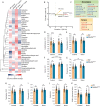Impaired mitochondrial complex I function as a candidate driver in the biological stress response and a concomitant stress-induced brain metabolic reprogramming in male mice
- PMID: 32488052
- PMCID: PMC7266820
- DOI: 10.1038/s41398-020-0858-y
Impaired mitochondrial complex I function as a candidate driver in the biological stress response and a concomitant stress-induced brain metabolic reprogramming in male mice
Abstract
Mitochondria play a critical role in bioenergetics, enabling stress adaptation, and therefore, are central in biological stress responses and stress-related complex psychopathologies. To investigate the effect of mitochondrial dysfunction on the stress response and the impact on various biological domains linked to the pathobiology of depression, a novel mouse model was created. These mice harbor a gene trap in the first intron of the Ndufs4 gene (Ndufs4GT/GT mice), encoding the NDUFS4 protein, a structural component of complex I (CI), the first enzyme of the mitochondrial electron transport chain. We performed a comprehensive behavioral screening with a broad range of behavioral, physiological, and endocrine markers, high-resolution ex vivo brain imaging, brain immunohistochemistry, and multi-platform targeted mass spectrometry-based metabolomics. Ndufs4GT/GT mice presented with a 25% reduction of CI activity in the hippocampus, resulting in a relatively mild phenotype of reduced body weight, increased physical activity, decreased neurogenesis and neuroinflammation compared to WT littermates. Brain metabolite profiling revealed characteristic biosignatures discriminating Ndufs4GT/GT from WT mice. Specifically, we observed a reversed TCA cycle flux and rewiring of amino acid metabolism in the prefrontal cortex. Next, exposing mice to chronic variable stress (a model for depression-like behavior), we found that Ndufs4GT/GT mice showed altered stress response and coping strategies with a robust stress-associated reprogramming of amino acid metabolism. Our data suggest that impaired mitochondrial CI function is a candidate driver for altered stress reactivity and stress-induced brain metabolic reprogramming. These changes result in unique phenomic and metabolomic signatures distinguishing groups based on their mitochondrial genotype.
Conflict of interest statement
The authors declare that they have no conflict of interest.
Figures





Similar articles
-
Hepatic bioenergetics and metabolism in mitochondrial disease: insights from the Ndufs4 KO mouse model.Metabolomics. 2025 Jun 11;21(4):76. doi: 10.1007/s11306-025-02275-7. Metabolomics. 2025. PMID: 40498175 Free PMC article.
-
Regional metabolic signatures in the Ndufs4(KO) mouse brain implicate defective glutamate/α-ketoglutarate metabolism in mitochondrial disease.Mol Genet Metab. 2020 Jun;130(2):118-132. doi: 10.1016/j.ymgme.2020.03.007. Epub 2020 Apr 3. Mol Genet Metab. 2020. PMID: 32331968 Free PMC article.
-
Metabolomics of Ndufs4-/- skeletal muscle: Adaptive mechanisms converge at the ubiquinone-cycle.Biochim Biophys Acta Mol Basis Dis. 2019 Jan;1865(1):98-106. doi: 10.1016/j.bbadis.2018.10.034. Epub 2018 Oct 31. Biochim Biophys Acta Mol Basis Dis. 2019. PMID: 30391276
-
Ndufs4 knockout mouse models of Leigh syndrome: pathophysiology and intervention.Brain. 2022 Mar 29;145(1):45-63. doi: 10.1093/brain/awab426. Brain. 2022. PMID: 34849584 Free PMC article. Review.
-
Emerging roles of brain metabolism in cognitive impairment and neuropsychiatric disorders.Neurosci Biobehav Rev. 2022 Nov;142:104892. doi: 10.1016/j.neubiorev.2022.104892. Epub 2022 Sep 28. Neurosci Biobehav Rev. 2022. PMID: 36181925 Review.
Cited by
-
Sub-Cellular Metabolomics Contributes Mitochondria-Specific Metabolic Insights to a Mouse Model of Leigh Syndrome.Metabolites. 2021 Sep 28;11(10):658. doi: 10.3390/metabo11100658. Metabolites. 2021. PMID: 34677373 Free PMC article.
-
CHCHD2 p.Thr61Ile knock-in mice exhibit motor defects and neuropathological features of Parkinson's disease.Brain Pathol. 2023 May;33(3):e13124. doi: 10.1111/bpa.13124. Epub 2022 Nov 2. Brain Pathol. 2023. PMID: 36322611 Free PMC article.
-
Chronic stress alters hepatic metabolism and thermodynamic respiratory efficiency affecting epigenetics in C57BL/6 mice.iScience. 2024 Feb 20;27(3):109276. doi: 10.1016/j.isci.2024.109276. eCollection 2024 Mar 15. iScience. 2024. PMID: 38450153 Free PMC article.
-
Early Life Stress and Metabolic Plasticity of Brain Cells: Impact on Neurogenesis and Angiogenesis.Biomedicines. 2021 Aug 26;9(9):1092. doi: 10.3390/biomedicines9091092. Biomedicines. 2021. PMID: 34572278 Free PMC article. Review.
-
Extremely Low-Frequency Electromagnetic Field (ELF-EMF) Increases Mitochondrial Electron Transport Chain Activities and Ameliorates Depressive Behaviors in Mice.Int J Mol Sci. 2024 Oct 21;25(20):11315. doi: 10.3390/ijms252011315. Int J Mol Sci. 2024. PMID: 39457098 Free PMC article.
References
Publication types
MeSH terms
Substances
LinkOut - more resources
Full Text Sources
Molecular Biology Databases
Miscellaneous

